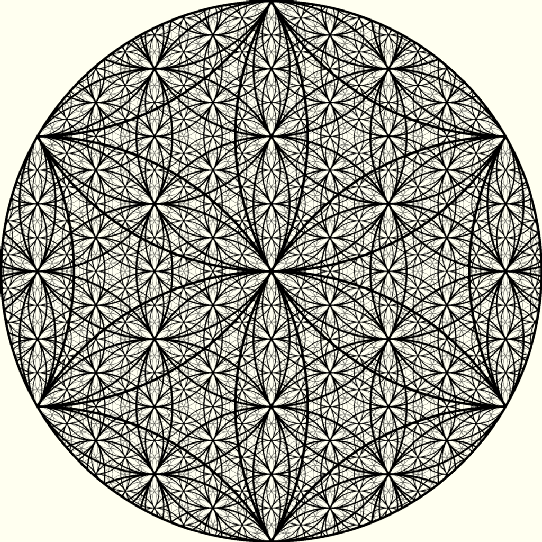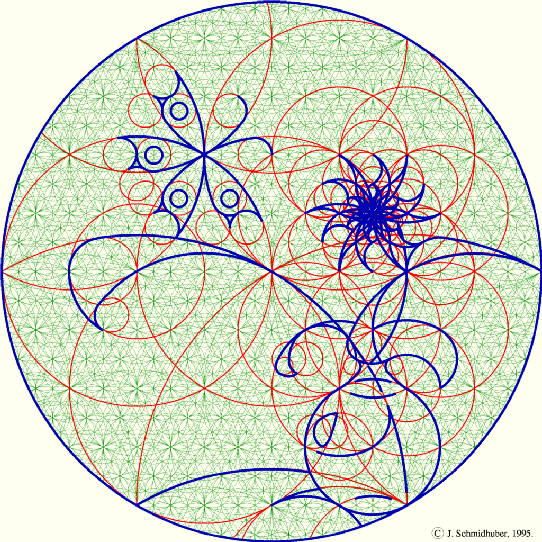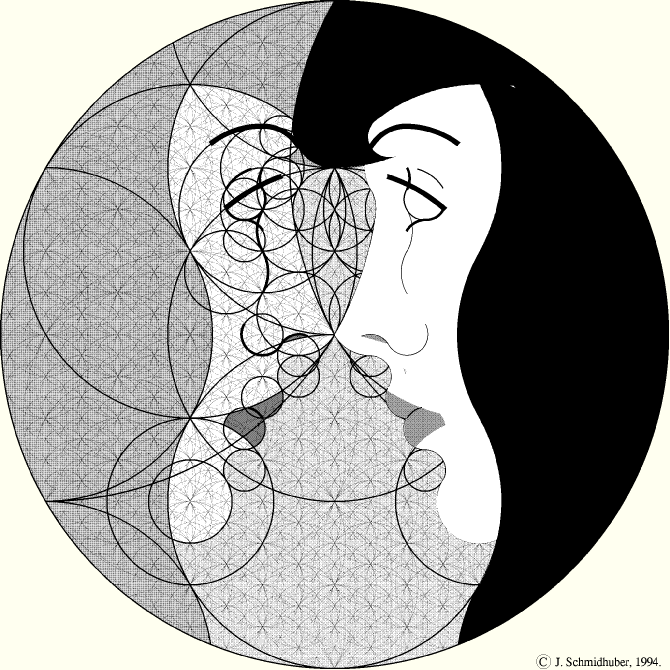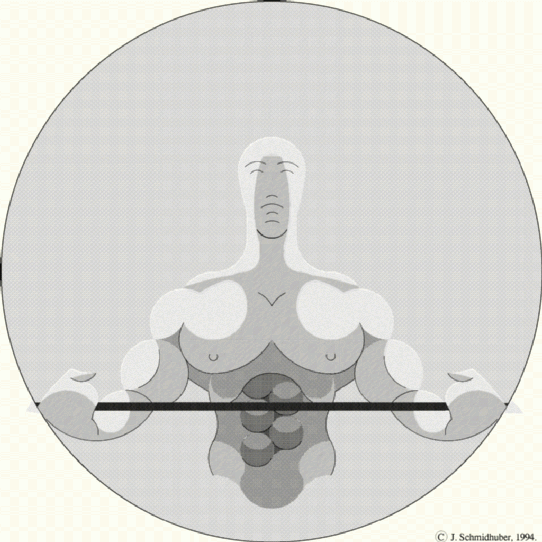
The following is a set of informal specifications of the cartoons I will present. NOTE: the original drawings printed in the journal Leonardo are of higher quality.
- Figure 2a: The (informal) goal was to draw a butterfly approaching a vase with a flower.
- Figure 3a: The goal was to design a woman's profile.
- Figure 4a: The goal was to design a logo for a gym based on a weight lifter's upper body.
Figures 2a, 3a and 4a are examples of cartoons designed by using Rules 1-6 only. Instead of providing each drawing's somewhat opaque coding sequence, I refer the reader to Figs 2b, 3b and 4b, which graphically illustrate the algorithmic simplicity of the corresponding cartoons. In conjunction with Fig. 1, each illustration allows the low Kolmogorov complexity of its corresponding cartoon to be described quickly to the human observer.
I should mention, however, that simplicity of expression is a defining feature of cartoons. Although great artists often are distinguished by their ability to communicate the most expressive content using the fewest strokes of brush or pen, successful cartooning using low-complexity drawings does not necessarily translate to other artistic disciplines.
The figures demonstrate that the circle scheme is quite flexible. In terms of bits, it is cheaper to encode all cartoons (Figs 2a, 3a and 4a) simultaneously than to encode each cartoon separately because the algorithm for generating legal circles and their numbers is shared by all three cartoons. In the terminology of algorithmic information theory, the cartoons share a nontrivial amount of mutual algorithmic information. The circle scheme can be viewed as something like a common recognizable artistic style.
A drawing that can be computed by a short algorithm typically exhibits strong relationships between the whole and its parts, essentially because the same short pieces of code have to be used repeatedly to generate all parts of the drawing. In the terminology of algorithmic information theory, there is a great deal of mutual algorithmic information (coherence) between different parts of the drawing and also between the whole and its parts. The circle cartoons exemplify this: many of their details are based on identical or similar shapes and arcs, computed by the same subprogram executed again and again. Likewise, many parts of the drawings are self-similar.
Fig. 1.
Fractal result of an iterative application of Rules 1 and 2
(following initialization). This self-similar figure builds the
basis of all the figures that follow. On each legal circle there
are the centers of six legal circles with equal radius. For
clarity, each legal circle is drawn with a width
proportional to the logarithm of its radius. Parts of legal
circles located outside the initial circle (the ``frame") are not
shown. Also, circles with radius less than 1/16 the radius of the
frame are not shown.

Fig. 2a.
Butterfly approaching a vase with a flower. Only Rules 1-6 were
used to design the drawing.

Fig. 2b.
Illustration of the low Kolmogorov complexity (or algorithmic
simplicity) of Fig. 2a. All circles shown are taken from Fig. 1;
very few of them, however, are needed to specify this drawing.
Many of the arcs are large and do not require many bits to be
specified.

Fig. 3a.
Woman's profile. Again, only Rules 1-6 were used to design the
drawing.

Fig. 3b.
Illustration of the low Kolmogorov complexity (or algorithmic
simplicity) of Fig. 3a. All circles shown are taken from Fig. 1.
Most of the circles used (drawn with thicker lines) are
comparatively large--their unique specification requires only a
few bits. Note the symmetries in nose, lips and chin --
many of the same contours reappear,
thus ``going together well''.


Fig. 4b. Illustration of the low Kolmogorov complexity (or algorithmic simplicity) of Fig. 4a. All circles shown are legal circles taken from Fig. 1. Note that shoulders and biceps/triceps are shaped by circles of equal size. This may be viewed as an idealization of what can be observed in certain human weight lifters. The same circle size is used for many additional features, such as the top of the head, parts of the chest, etc. Mirror symmetry is broken only for the abdominal muscles. The visible part of the dumbbell belongs to a legal circle with nearly infinite radius (drawn with a huge but legal arc width).

Related work: J. Schmidhuber.
Facial beauty and fractal geometry.
Note IDSIA-28-98, IDSIA, June 1998
(ca. 0.6 M, including 5 color figures).
Postscript
(1.29M, ca. 4.96 M gunzipped).
A more complicated example of low-complexity art: Femme Fractale.
Check out how the Formal theory of creativity (1990-2010) explains science, art, music, humor.